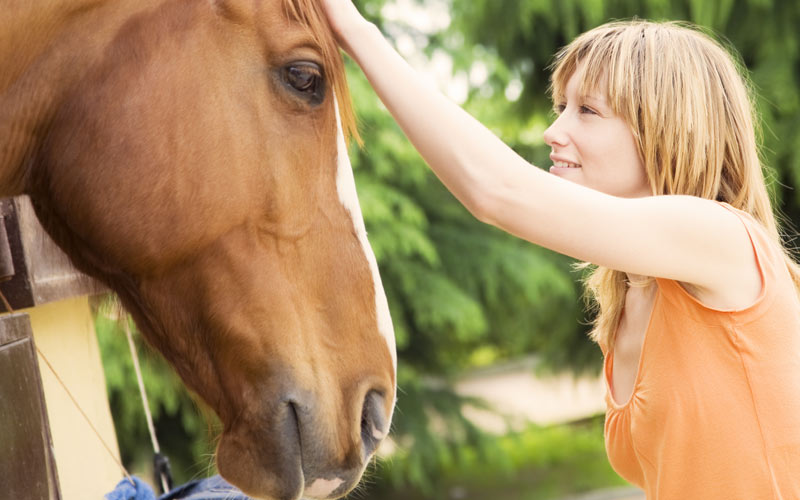TTouch can help your horse in times of injury or illness. And best of all – you can do them yourself!
As horse owners, we spend countless hours and dollars preventing injury and illness in our equine friends. Unfortunately, these precautions can only go so far. If you have horses for long enough, you will likely encounter some form of injury or trauma. The Tellington TTouch Method offers some simple techniques that can help reduce healing time, ease handling for treatment, and stabilize a colicking horse while awaiting veterinary assistance.
TTouch for Injuries
One of the most wonderful things about TTouch Bodywork techniques is that they can be applied lightly enough to be used around wounds, bruising, swelling or other traumas to the tissue, without causing pain. Doing small, gentle TTouches all around the point of an injury has been found to increase circulation, reduce inflammation, and promote blood flow to the tissue. Spending just a few extra minutes each day doing this will help speed healing and relieve discomfort.
The Raccoon Touch
The Raccoon TTouch is probably one of the most useful techniques to apply around any kind of injury. It’s simple to learn. Curl your hand so that just the tips of your fingers make contact and pick a point to make contact with the tissue. It is important to start as far away from the actual point of trauma as necessary to maintain your horse’s trust and let him know you are listening and are not there to inflict pain.
Using the lightest pressure you can while still moving the tissue, move your fingers in a circle-and-a-quarter motion without sliding across the hair. You will feel as though the circle is tiny and that the skin hardly moves under your fingertips. In many cases, you may feel as if the tissue in your own fingertips moves more than the horse’s. Using light, fast circle-and-a-quarter motions, move all around the injury, backing off a bit if the horse seems uncomfortable. Be sure to pause for a moment between each circle-and-aquarter, and remember to breathe. This circular motion ensures that the tissue is lifted and supported at the beginning and end of each TTouch. Taking just a few minutes each day to do Raccoon TTouches all around an injury can go a long way towards supporting the healing process.
Simplify Veterinarian Treatment
In many cases, one of the most trying aspects of having an injured or sick horse is administering the prescribed veterinary treatment. Taking a few moments to prepare your horse can make the entire procedure much easier and less time-consuming, while maintaining a good level of trust with your horse.
Before you administer an injection or eye medication, take a moment to prepare your horse by doing Raccoon TTouches all around the area you will be treating. Sometimes it is the surprise that creates the most resistance in horses. Taking 30 seconds to make mindful contact can begin to relax a tense horse and put a positive spin on an otherwise unpleasant situation. Excessive tension in the tissue will make injections more painful and set up a negative experience for future applications. The more relaxed your horse is for an injection, the better future procedures will be.
The Nostril Slide
Should you find yourself in a situation where your horse needs to be tubed for colic, a simple Nostril Slide can make this unpleasant experience a little easier. While your veterinarian is preparing his instruments and solution, take your fingers and gently make contact with your horse’s nostrils. If the horse is suspicious, take 30 seconds to apply Raccoon TTouches around the muzzle to help him relax.
Take your thumb and forefinger and gently slide down and forward along the flare of the nostril. Many horses find this technique very relaxing and it helps trigger the parasympathetic nervous system, which promotes relaxation. Experiment with speed and pressure, as each horse is different. If your horse has enjoyed this technique previously, he will relax more readily and give your vet an easier animal to deal with.
Ear Strokes
Finding your horse showing the telltale signs of colic – off his feed, despondent, rolling, pawing, and agitated – is the last thing you want. When faced with a situation of colic or severe distress, two simple exercises can help reduce agitation, stabilize heart rate and respiration, and prevent the onset of shock while you await veterinary assistance.
Once you have called your vet and recorded heart rate and respiration, begin Ear Strokes right away. Facing the horse’s head, or from the side if you are walking the horse to keep him up, place your hand at the base of the ear and firmly stroke the ear out to the side and slightly forward, from the base all the way to the tip. The ear will fold slightly in your hand and your thumb will end up at the tip of the ear.
The tip of the ear is an acupuncture point for shock. Shock is often as life-threatening as the colic itself, so it is imperative to keep your horse in as stable a condition as possible while awaiting professional help. Alternate Ear Strokes between the right and left ears as often as you can. Ear Strokes can help lower heart rate and respiration, so be sure to stop while you or your vet are measuring vital signs.
Belly Lifts
These are another excellent tool to use when faced with a bout of colic. Using a towel, girth, sheet, or anything you can get your hands on, stand across from another person right behind the elbow of the horse. If you are alone, use a large sheet, towel, girth, or surcingle that is large enough to encircle the horse’s entire barrel.
Place the towel at the girth and, counting up to three or four, slowly lift. Pause, and then release the pressure twice as slowly as you went up. For instance, if you counted up to three, count down to at least six. You should notice your horse expand his diaphragm and alter his respiration.
Continue, slowly moving as far back as the horse will allow. Be sure to stay clear of the kick zone, should he become uncomfortable as you move further back. Repeat from front to back as often as you can. Belly Lifts seem to reduce some discomfort and help increase movement through the body. Often, you will find that gas (and even manure) is released after several Belly Lifts.
No one wants to be faced with injury or illness in their horses, but the more tools you have to deal with these situations, the better. Remembering these few simple exercises can give you some proactive, beneficial things to do to improve your horse’s well-being in a situation that otherwise renders you helpless.
The Right Amount of Pressure
Try the Raccoon TTouch on yourself first, testing the pressure by placing your fingertips just under your eye. Supporting your elbow with your other hand, allow the tips of your fingers to make contact over your cheekbone. Now make the circle-and-a-quarter motion, noticing how little pressure is required to move the tissue without sliding across the skin. A “1” pressure, or the lightest pressure on the TTouch pressure scale, would mean you would not even feel your cheekbone under your fingers.
Getting Comfortable
For any type of injury, the most important thing to remember is to let your horse dictate what is comfortable or not. It is often useful to do what you plan on doing around the injury on the opposite side of the horse first (for example, if the right forelimb is injured, start by spending a minute on the left forelimb).
Be sure to use the same light pressure that you plan on using around the injury. This gives the horse a chance to know what you are going to do, without having the added defensiveness of pain, and will help build trust when handling the injured area.
If your horse is suspicious of what you are doing, experiment with different parts of your hand in making the light circle-and-a-quarter – sometimes starting with the back or palm of your hand can diffuse the feeling of contact.
Mandy Pretty is a certified Tellington TTouch and Connected Riding Practitioner. She has taught workshops throughout North America and Australia helping horses and their humans achieve well- being, performance and harmony through low-stress, bio-mechanically healthy methods. Her articles have appeared in several publications around in various countries. intouchwithyourhorse.com








